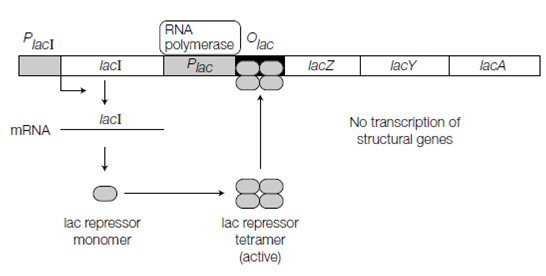The lac repressor:
the lacI gene has its own promoter (PlacI) which leads to transcription of lac repressor mRNA and binds RNA polymerase and although production of lac repressor protein monomers. There are four identical repressor monomers come together to form the active tetramer which can bind tightly to the lac operator site, Olac. The sequence of Olac is palindromic, which is it has the similar DNA sequence when one strand is read 5 to 3 and the complementary strand is read 5 to 3 . This symmetry of the operator site is coordinated through the symmetry of the repressor tetramer.
In the absence of an inducer like as IPTG or allolactose, the lacI gene is transcribed and the resulting repressor protein binds to the operator site of the Olac, lac operon, and prevents transcription of the lacY lacZ, and lacA genes in the given figure. During induction, the inducer binds to the repressor. This causes a modification in conformation of the repressor which hugely decreases its affinity for the lac operator site. The lac repressor presently dissociates from the operator site and permits the RNA polymerase already in place on the adjacent promoter site to start transcribing the lacy, lacZ and lacA genes in the figure. This yields several copies of the polycistronic mRNA and after translation, huge amounts of all three enzymes.
If inducer is erased, the lac repressor rapidly binds to the lac operator site and transcription is inhibited almost instantly. The lacZYA RNA transcript is very unstable and so degrades rapidly such that further synthesis of the permease, -galactosidase and transacetylase ceases.

Figure: Repression of transcription by the lac repressor in the absence of inducer.